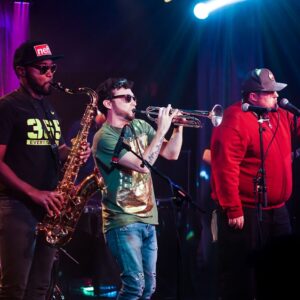Is Christian Rock As Lousy As The New Yorker Says It Is?
Anti-Christian sentiment—whether subtle or overt—has so long infused the world of rock and roll that its existence is often ignored and its impact uncontested.
In 1985, Charles M. Young, an MTV interviewer (and veteran rock critic) asked Bob Dylan if it was a “fair perception” to say that “during your Christian period there seemed to be an element of self-righteousness in your work”?
The question, and Dylan’s perky response, can be heard around the 3:28 mark:
Dylan could have just as reasonably responded by asking, “Do you have any examples to back up your view, Mr. MTV?”*
Or: “You hear more self-righteousness in my gospel lyrics than in my secular lyrics—really?”
Like everyone else with access to a media perch, or soapbox, I’m biased too. My bias is pro-Christian.
For fun, I’ll try to support this notion that some of Dylan’s classics might suffer, if any of his work does, from self-righteousness:
From “Like a Rolling Stone,” these lines:
“How does it feel / To be…a complete unknown?”
From “Ballad of a Thin Man”:
“How does it feel to be such a freak?”
From “A Hard Rain’s Gonna Fall”:
“I hear the roar of a wave that could drown the whole world”
Don’t get me wrong. Dylan charms me. But surely these hits of his exude at least a whiff of self-righteousness.
Interviewers, of course, ask hard questions. But don’t you sense that Young probably would not be as quick or sensitive in perceiving self-righteousness in secular rock? That possibly, even tame Christianity would get his goat?
I’m not using this Dylan-MTV exchange to charge everyone in the media with disliking Jesus. I just need a warm-up act for my analysis of Kelefa Sanneh’s New Yorker article of September 24, 2018: “True Believers: The Unlikely Endurance of Christian Rock.”
*I still wonder what prompted Young’s view. I am familiar with Dylan’s “Christian period,” which is said to have spanned the years 1979 through 1981 and resulted in three “gospel” albums, and haven’t myself heard the self-righteousness in question.
In his article, Sanneh devotes a paragraph to Greil Marcus’s “brutal review of ‘Slow Train Coming,’ one of the albums Bob Dylan released during his Christian period. Marcus accused Dylan of trying to pass along ‘a prepackaged doctrine he’s received from someone else.”
Marcus, a Dylan expert, is formidable. But why lament that Dylan passed along views consistent with the faith rather than inventing his own religious doctrine? Perhaps Marcus is one of those Dylan zealots who himself would be tempted to kneel down in a Bob pagoda or temple.
My take on Dylan’s “Slow Train Coming,” by the way, is that, in both lyrics and music, it is, at times, convincing and inspired. At other times, not so much. Typical Dylan, in other words
Here’s a live take of my favorite track, “Precious Angel.” If you haven’t heard the LP version, you should, if only for the beautiful guitar lines by Mark Knopfler:
1. Before we get into the bigger problems with Sanneh’s article, some quibbling about terminology must be endured.
Music critics, and the people who read them, tend to be fussy.
If you don’t want to get lost, or pummeled, in debates over minutiae, don’t be wrong about who played what, when, where, and how; don’t confuse an alto with a tenor kazoo; or death grind with death-doom; and, remember, two southpaws, not one, starred in The Beatles.
Despite the silliness of rock and roll pedantry at its most extreme, primary terms help us to avoid confusion or to save time. And in an article that positions itself as a trustworthy, if not an authoritative, guide to a musical genre, accuracy about key terms seem essential.
But rather than being lucid, Sanneh is confusing about the vastness that is gospel music, writing: “In gospel music, form and content are joined: the term denotes both a style and a message, leaving no room for theological ambiguity.”
With content he is clear: he means religious lyrics.
But what one style, or one form, denotes, for Sanneh, the totality of gospel music?
He doesn’t say.
Some people, even some music experts, think gospel music only covers African-American styles.
And Christian music only covers white styles.
The stubborn reality is that many blacks and whites call the religious music they hear or play, whether it’s black bluegrass or blue-eyed soul, gospel music.
If you think I’m exaggerating, type in gospel music on eBay or Google and try to unscramble the massive, multiracial variety that will engulf you.
A critic can try to displace such common usage, but why?
Certainly, one authority, AllMusic.com, catches intricacies bobbled by Sanneh:
“Gospel essentially breaks down into three separate categories. For many listeners, the word ‘gospel’ conjures the sound of large African-American Southern gospel choirs, singing joyous songs of celebration. These grew out of traditional spirituals and would later evolve into close-knit, small combos that were the blueprint for doo-wop groups. Another style of gospel was country gospel, which sounded like traditional country with lyrics about God. These two forms, along with blues gospel, which was never quite as widespread as country gospel, provided part of the foundation of contemporary gospel and CCM (Contemporary Christian Music), which came into existence in the late ‘70s.”
In this way, gospel music describes a plurality of styles and forms: country, blues, rock, rockabilly, bluegrass, R&B, soul, blues, funk, and whatever subgenre I am forgetting. Christian music, meanwhile, tends to label white rock or white pop. Should it?
I question how much of this universe Sanneh has heard, or understood, if he’s not even sure what “gospel music” sounds like.
In contrast, Sanneh is decidedly unmoved, in his “True Believers” analysis, to list bands that might charm—let alone convert—listeners who think they hate early Christian rock.
2. Sanneh begins his discussion of Christian rock on firm ground: with Larry Norman.
Nobody should doubt Larry Norman’s force as a Christian rock pioneer—or his charisma:
Sanneh writes: “Many historians trace the birth of Christian rock to the release, in 1969, of ‘Upon This Rock’ [by Larry Norman].”
Sanneh also calls Norman “the father of Christian rock.”
But Norman was a popularizer; an energizer. He advanced a genre that had already been born—an act that is hardly the same as giving birth.
Even the laziest of research would’ve forced Sanneh, or his fact-checker, to see that Christian rock predates Norman’s 1969 solo debut.
The laziest research in question has a name. Here is Wikipedia on the roots of Christian rock.
“Among the first bands that played Christian rock was The Crusaders, a Southern Californian garage rock band, whose November 1966 Tower Records album ‘Make a Joyful Noise with Drums and Guitars’ is considered one of the first gospel rock releases or even ‘the first record of Christian rock,’ and Mind Garage, ‘arguably the first band of its kind,’ whose 1967 ‘Electric Liturgy’ was recorded in 1969….”
Perhaps Sanneh meant to say that “many historians trace the growth of Christian rock to…‘Upon This Rock.’”
Do I need to add that accuracy improves, rather than harms, a critical argument?
***
The chief scholar of early Christian rock is a guy named Ken Scott. He has dug up, heard, and critiqued—with acuity—a mountain of Christian rock records. I can almost envision the clutter in his music room.
Scott’s groundbreaking work is titled “Archivist: Vintage Vinyl Jesus Music 1965-1980.”*
In the 4th Edition, Scott writes: “No matter how you slice it, the conclusion is inescapable: with regard to ‘Jesus rock’ the British were the first.”
Yet Sanneh manages to slice through the inescapable by misplacing a crucial chunk of Christian rock of history (the garage and semi-psychedelic period of 1964-1968).
The effect is to divert his intelligent readership from thinking there is any Christian rock worth listening to before Larry Norman. Imagine convincing people that no good secular rock appeared before 1969.
From Ken Scott I learned to love such British precursors to Larry Norman as: The Pilgrims, The Envoys, The Crossbeats, The Joystrings, The Cobblers, The Witnesses, The Pebbles, The Liverpool Raiders, The Peacemakers, and The Concords.
About The Concords, Scott writes: “Larry Norman may not have been in diapers when this group first began playing, but he may very well still have been picking his nose.”
***
Here are a few audio samples by early Christian rock bands whose music can still grab you by the ears. That is, if you dig raw-boned garagey sounds:
A classic slab of under-produced directness:
In this way, I hear Roy Orbison meshing with “Rubber Soul”:
Scott catches much, but the field is so deep, and wily, that it is not reasonable to think one person, however discerning, can catch everything. Here’s a rare slice of Christian Brit beat that slipped by the “Archivist”:
***
The American rock musicians** who precede Larry Norman (or also popped up in 1969) include: The Search Party, Bill Comeau, Ray Repp, The Holy Ghost Reception Committee #9, John Ylvisaker, God Unlimited, and, a personal fave, the Sons of Thunder, a misnamed band that had more females than males (and was also multiracial).
Many lovers of Christian rock could add, but both my lists improve, I hope, on Sanneh’s silence:
First they were garage:
Then they were folk-rock:
And here comes Christian psychedelia (called “Xian psych” by collectors):
***
SUMMARY: Even if “many [unnamed] historians” support it, no critic is obliged to pass along false history.
*The two pre-Larry Norman Christian rock bands named by Wikipedia, The Crusaders and Mind Garage, are also worth investigating:
**For those wishing to dig deep into the genre of early Christian rock, I recommend Scott’s hefty and invaluable: “Archivist: Vintage Vinyl Jesus Music 1965-1980.”
Meanwhile, there’s a shorter introduction to some of the best of early Christian rock in an article by David Hollandsworth called “A Decade of Jesus Music 1969: Top 50 Collectible Jesus Music Albums of All Time.”
About Norman’s “Upon This Rock,” Hollandsworth writes: “Reported to be the first Jesus rock lp in existence, but there are a couple of lps that predate it. It also must be stated that Larry Norman was not the only one doing Jesus rock at the time, but he did have the widest exposure because of his contract with Capitol.” In 1968, Norman’s previous band, People!, released a record on Capitol.
To find this semi-hidden article, go to: one-way.org/jesusmusic/index.html, and, once there, locate the “index,” on the left side of your screen. Within the listings of the index you must click on “Top 50 Albums” to access the article.
Anybody looking for an intelligent primer to mainstream Christian rock should try: “The Rock & Roll Rebellion: Why People of Faith Abandoned Rock Music—and Why They’re Coming Back” by Mark Joseph (1999). The book provides lively analysis and should lead the curious listener to some of the best mainstream acts.
Joseph also could’ve been more precise about how Larry Norman popularized, rather than created, Christian rock. In “The Rock & Roll Rebellion,” Joseph writes that Norman’s “Upon This Rock” is “widely acknowledged to be the first ‘Christian Rock’ album.”
Joseph wrote that in 1999—before the internet was crammed with deeper research and better clues.
A new book by Joseph called “Rock Gets Religion: The Battle for the Soul of the Devil’s Music” is mentioned a few times by Sanneh. I have not yet read that book.
3. “Like many rock stars of his generation, Norman was proudly anti-establishment.” –Kelefa Sanneh
If Sanneh means to link Norman’s antidisestablishmentarianism* with, say, Robert Plant’s or Mick Jagger’s, he’s plumb wrong.
Many rockers were opposed to drug laws, abstinence, and, of course, religion. The only way to shove Larry Norman into alignment with this group is to distort his core beliefs: i.e. cultural appropriation.
One of Norman’s songs, “Reader’s Digest,” a Dylanesque romp, is an explicit criticism of “many rock stars of his generation”:
“The Rolling Stones are millionaires / flower children pallbearers”
And:
“I don’t dig the radio, I hate what the charts pick /
Rock and roll may not be dead, but it’s getting sick”
And:
“The Beatles said, All you need is love /
and then they broke up Jimi took an overdose, /
Janis followed so close”
Every line of “Reader’s Digest” is a clear smack. I’d suggest listening to the whole thing:
*The longest non-technical word in the dictionary. I’ve waited 35 years to use it. Hear also Duke Ellington’s: “You’re Just an Old Antidisestablishmentarianismist:”
4. Grouping Larry Norman’s beliefs with the beliefs of “many rock stars” is not the only time Sanneh tries to shove a person—who can’t speak back—into a secular setting. In reference to a book by Randall J. Stephens called “The Devil’s Music,”* Sanneh claims Stephens “points out that many pioneering rockers, from Sister Rosetta Tharpe to Jerry Lee Lewis, came out of the Pentecostal Church.”
A musical artist is commonly said to “come out of the church” when he or she abandons religion to chase fame and riches in a secular genre. It is often remarked, for example, how the raging secularist Kelly Clark came out of a Christian background.
Another example: Jerry Lee Lewis sure did abandon the church to cut a stage-shaking, piano-blazing figure in the early days of rock and roll. No doubt.
But Sister Rosetta did not abandon the Pentecostal Church or her faith. When she died, in 1973, she was still a Christian and still a musician, both.
To say she came out of something she most certainly stayed in is to dismiss—rather rudely, I think—the very meaning of her glorious work.
Yes, Sister Rosetta sometimes played secular tunes (what singer hasn’t?), but her heart was in gospel and her music career, more or less, followed suit.
Instead of mislabeling a stalwart like Sister Rosetta simply do your research and find somebody who fits your “came out of the church” argument—like Little Richard or Sam Cooke.
For those who haven’t yet heard the divine musicality of Sister Tharpe, here she is, fuzzed-up guitar in tow, doing “Up Above My Head” (early 1960s):
If you like this performance, all of her work should appeal to you.
*Although he mentions the subtitles of other books he reviews, Sanneh doesn’t mention the subtitle of “The Devil’s Music,” which is peculiar since without that subtitle you can’t comprehend the book’s aim. The subtitle is: “How Christians Inspired, Condemned, and Embraced Rock ’n’ Roll.”
5. Sanneh praises a new biography of Larry Norman* for seeing “Norman as a genius and prophet, clear-eyed in his criticism of what he called ‘the apostate church.’”
The implication is loaded and cocked: Sanneh wants the reader to think that “the apostate church” was the primary target of Larry Norman’s “clear-eyed…criticism.”
But was it? Nope.
Throughout history, many Christians, including Jesus, have criticized the church. But that doesn’t mean criticizing the church is the essence of their message. It wasn’t.
Norman’s criticism was first and foremost directed at the failures and traps of not believing in God.
Here’s a clip of Norman being “clear-eyed” in criticizing secular “radicals” who idolize politics over faith:
*“Why Should the Devil Have All the Good Music? Larry Norman and the Perils of Christian Rock” by Gregory Alan Thornbury (2018)
6. “Two men walking up a hill
One disappears and one’s left standing still
I wish we’d all been ready
There’s no time to change your mind
The Son has come and you’ve been left behind.”
These lines from the “best-known” Larry Norman song, “I Wish We’d All Been Ready,” appear to rankle Sanneh. They sound, Sanneh reports, “like a child repeating a terrible nursery rhyme.”
“Terrible” in what way?
He goes on: “In print, the song looks like a stern warning about the Rapture.”
Rather than being direct about his feelings toward Christianity, Sanneh plays the role of impartial judge.
The word “stern,” however, is pointed, not impartial.
Pointed: if somebody thinks of you or your opinions as “stern,” it’s not a compliment.
Pointed: If a pal warns you to take your eyes off your iPhone because you are about to fall into a pit of quicksand, her warning is less on the “stern” side and more of the “friendly” persuasion.
***
The religious views of a writer are often irrelevant to the subject we’re reading. But when the subject is religious content?
Dear reader, it’s time I let you in on a little secret: Kelefa Sanneh is no more impartial than I am.
7. The only era of Christian rock with which I have some familiarity ranges from circa 1964 to circa 1980. Meaning when Stryper and their hair appear on the scene, I don’t know much. And when Sanneh starts up his views on the “Christian punk scene” and Christian “thrash-metal” and Christian metal-core” and Christian “screaming emo,” he loses me.
Or, more accurately, I hide.
But early Christian rock is a passion of mine—and if you, like me, want to hear the best of it, it’s mandatory to dig deep beneath the mainstream. The mainstream scene has its charms, but does not get close to representing the vastness of the genre or the best of it.
Early Christian rock is not the only music style I’m avid about. I also pursue: early blues, early funk, early soul, early folk, and early country, and to hear the best of each, the same pushy action is required: digging.
Many serious music lovers understand this—to hear the best you must dig.
But there is another problem, Sanneh’s biggest one. Besides being fenced-in by his attraction to the most superficial offerings of the mainstream, Sanneh doesn’t seem to hear, or care about, the difference between pop balladry and rock and roll.
Sanneh and I agree that Larry Norman was a paramount force in Christian rock—an image of Norman even illustrates the piece.
So, please, yes, begin your “Christian rock” survey with Larry Norman. But to leap from analyzing Norman to analyzing a crowd of soft pop artists feels like a straight-up bait-and-switch ploy.
The first act after Norman that Sanneh mentions is Love Song, “a breezy band that helped codify [in 1972] the soft sound of early Christian rock.”*
Then he mentions Marsha Stevens and a famous “folk song” of hers (if anything, it’s a folk-pop ballad).
Then he touches on B.J. Thomas (whom he calls a “pop-country singer”) and then Evie (a “balladeer”).
What do Love Song, Marsha Stevens, B.J. Thomas, and Evie have in common?
They’re all pop musicians who specialized in soft music, not rock and roll.**
To remind you, the subtitle of Sanneh’s article trumpets the term “Christian Rock,” not “Christian Pop.”
But lest there is any confusion: my disagreement with Sanneh has nothing now to do with semantics or labeling—about how, at this late date, we should define “pop” or “rock.”
My disagreement is that Sanneh judges ballads when he should be judging rock songs.
The two—ballads and rock songs—should not sound the same to a critic.
Of course rock bands play ballads. But that truth does not magically cause the softest of balladry to transform into galvanic, thumping rock and roll.
The Rolling Stones have recorded a handful of country songs. That does not mean you will find their records under “hillbilly.” The Stones also cut some disco and reggae.
Would it be any more reasonable if I judged secular rock by reviewing a handful of songs by Pat Boone, Helen Reddy, Christopher Cross, and Tony Orlando and Dawn?
***
Having inserted Love Song, Marsha Stevens, B.J. Thomas, and Evie into his takedown of Christian rock, who else is left for Sanneh to evaluate but Amy Grant, surely the softest queen in of Christian popdom?
Sanneh praises three songs of Grant’s: “My Father’s Eyes,” “1974,” and “Baby, Baby.”
The first song is pop. The second song is pop. And the third song is pop.
The other two Amy Grant ballads mentioned by Sanneh are also cushioned in doughy softness and you can look them up for yourself if you don’t believe me, but here is Grant doing “My Father’s Eyes” (1979):
*Sanneh’s description of the band Love Song would hardly entice me to give them a listen—if I didn’t already know them a bit. But I really liked their 1972 debut and this live version of “Let Us Be One” is likewise spirited:
**For some reason, Sanneh mentions a Dennis Quaid movie, “which tells the story of how Bart Millard came to write the ballad of the same name, one of the most beloved Christian rock songs.” He also spotlights the ballad “Reckless Love” by Cory Ashbury, “one of the biggest and most memorable worship songs of the past few years.” Enough with the ballads, dude! And isn’t People Magazine, or a morning T.V. show, the kind of locale for this “biggest” and “most memorable” blurbing, not The New Yorker?
8. In his section on early Christian rock, Sanneh mentions Marsha Stevens, the artist “who wrote ‘For Those Tears I Died,’ a folk song that became a contemporary-Christian favorite.”*
Embarrassed that I had not heard of Marsha Stevens, or her song, I leapt over to YouTube.
What first came up was Marsha Stevens’s own version of “For Those Tears I Died,” and here is that link:
Yikes.
Maybe the problem is with me, but I can barely tolerate this kind of sugary, over-produced pop. The singing, though perhaps technically excellent, is so arch that it distances me from any merit that may be in the lyrics.
With all the top-notch Christian rock to introduce to a hip New Yorker readership, Sanneh highlights…this?
And maybe it’s just a taste-quarrel between Sanneh and me. The only way to prove more solidly that Sanneh’s taste and mine diverge is if I found a photo of him in mom jeans.
But again, a pop ballad is not rock and taste has nothing to do with that difference.
Yet, after hearing “For Those Tears I Died,” something nagged at me: Could there be two Marsha Stevens and I had found the wrong one? Or was a superior cover version of this song hiding out somewhere? Sanneh, after all, specified that Stevens wrote this song–not that she sang it—and it pays to read between the lines of what Sanneh writes.
Even though such doggedness is not, I believe, the common reaction to hearing a song you dislike, I stayed to poke around some more on YouTube in the hope of finding…something.
Then: Eureka!
A superior version of “For Those Tears I Died” materialized. And guess who is singing it? The same Marsha Stevens! This time her singing is not operatic, but warm, and that’s how I can get closer to the lyrics (which I hear now are well-crafted and poignant).
And rather than being overproduced, the relaxed acoustical hippie-playing of her band, the Children of the Day, grounds the performance.
I’m impressed:
I don’t know what prodded me to keep looking after the first version I heard on YouTube, but it wasn’t Sanneh’s vague writing.
***
It’s not even true that all Christian rock balladry is syrupy. (Too much of it is, perhaps, but neither Sanneh nor I can give you the numbers to support either of our claims.)
The simple truth is that good balladry also occurs…in Christian music.
Here are some examples:
The following ballad, though obscure by mainstream standards, has long been enjoyed by vinyl fiends, and the record in which it can be found was reissued in 2008 by Subliminal Sounds:
Every album by The Bridge of Greensboro, North Carolina, is an artistic triumph—and a joy. From their second release:
This song is King James of The Lord’s Prayer set to rock music and every time I hear it I am dazzled:
And if you are going to mention balladry and Christian rock, why not discuss Victoria Williams instead of Amy Grant? Not because I think Grant lacks talent; she just doesn’t fit into a discussion of rock. Plus, she’s already way famous. If you feel compelled to introduce Amy Grant, you might as well say a few words about Elton John and Elvis too. Williams’ voice has idiosyncratic power and won’t work on everyone. But I consider the following to be a mystic gem:
And Williams doesn’t just play ballads:
***
Sanneh ends his entry on Marsha Stevens with these sentences:
“In a recent memoir, Stevens recalls the Jesus [Christian Rock] Movement with mixed feelings. She writes that women were expected to be ‘submissive,’ both in the church and in her band—Smith [Chuck Smith, the leader of Calvary Chapel] appointed one of her male bandmates the leader. Stevens says that her relationship with Calvary disintegrated after she told Smith that she was gay. She writes that he responded coldly, ‘with conviction and a tinge of condemnation,’ and suggested that she simply hadn’t married the right man.”
Anecdotes can move us close to individual truth. But they often can’t speak directly about thousands of experiences or thousands of people. Or millions.
Yet Sanneh emphasizes this anecdote. Why?
Perhaps this is where his bias comes out of the shadows.
Even though Sanneh admitted that Stevens had “mixed feelings,” meaning both positive and negative feelings, about the Jesus Movement, notice that the anecdote focuses only on the negative.
Where’s the other part of the mix?
Beyond its emphasis, there are other possible issues at play:
A. Do we even know for sure that the anecdote fairly represents what happened between Martha and Chuck? Before expressing a judgment—especially in public—wouldn’t it fair to get Chuck’s side of the story?
B. Can one anecdote fairly represent the totality of the Jesus Movement? Or the Calvary Church? Or Chuck Smith?
C. On a list of the many troubling things that happen in this world, where would feeling a “tinge of condemnation” rank?
D. Do “tinges of condemnation” happen in other movements, even in secular ones?
E. What does this anecdote have to do with Christian rock?
***
Despite these concerns I am willing to assume, for argument’s sake, that Stevens’ anecdote is accurate.
Conclusion: I wish Chuck Smith had been a “tinge” sweeter to Stevens.
Everybody happy with that?
If so, we can return to talking about Christian rock.
***
Some media bias is overt; some is subtle. Sanneh is subtle.
I certainly don’t pick up a hater’s vibe from Sanneh. And there are worse journalistic sins than to be a lazy and confusing guide to Christian rock. (Or to think ballads are no different from rock songs.)
That said, critics who judge art, and artists, shouldn’t judge with hidden agendas nor should our bias cause us to be sloppy or unfair.
In a piece that judges Christian content, Sanneh’s editors should have inspired Sanneh to be upfront with his views on religion. Such directness would’ve allowed readers to place his judgments in context and to smoothly navigate them.
It’s the sneakiness that feels wrong.
9. After obeisance to the pop queen Amy Grant, Sanneh appraises DeGarmo & Key. Finally, a rock band! (Albeit a very mainstream one.)
Sanneh: “DeGarmo & Key…specialized in songs so lumbering and artless that they resembled parodies (one was called ‘God Good/Devil Bad’).”
“God Good/Devil Bad” is narrated by a man who meets a stranger who “had a tattoo on his arm of Jesus / and the Devil side by side.”
The narrator goes on to challenge the stranger’s confusion:
Did that Madonna finally drive you crazy /
mixing sin with God on you?
Or did some rapper use some nasty language /
with a cross around his neck?
Perhaps there is a lumbering artlessness to the phrasing here. But there is also some thinking going on and in that almost novel way, the song rises over so much cliched and brain-dead rock and roll content.
I’m thinking of such lyrical clunkers as:
“Rock and Roll” by Led Zeppelin
“It’s Only Rock ’n Roll (But I Like It)” and “She’s So Cold” (and “She Was Hot”) by The Rolling Stones
“I Want You (She’s So Heavy)” and “Why Don’t We Do It in the Road” by The Beatles
***
But why is Sanneh even singling out “God Good / Devil Bad”?
Does he think it’s vital that, in his survey of Christian rock, the reader should know of the author’s particular dislike of this mainstream act? Or does he think that by trashing a few lines from one song he somehow proves a bigger point about Christian lyrics in general?
He doesn’t say.
10. And, finally, the biggest whopper from the menu of miscues to be found in “True Believers: The Unlikely Endurance of Christian Rock”:
“And many of the best albums to emerge from the Christian rock world have been the product of musicians who eventually distanced themselves from it, like Leslie Phillips, a singer-songwriter who renamed herself Sam Phillips and went secular, or mewithoutYou, a Philadelphia post-hardcore band that combined Christian teachings with Sufi poetry.”
First, Leslie Phillips and mewithoutYou are not albums, but acts.
Second, I would be keen to know which Leslie Phillips album Sanneh thinks is among the “best” of Christian rock. (Due to my ignorance of contemporary music, I’ll not touch the mewithoutYou claim. Also, why categorize a Christian-Sufi band as “Christian” and not “Sufi”?)
A cursory search of the sounds of Leslie Phillips on YouTube brought to mind more Amy Grant balladry.
(Of which Sanneh cannot seem to get his fill.)
Example:
If Sanneh is convinced that Phillips is responsible for one of Christian rock’s “best” albums, the onus is his to prove it (or at least name it).
But again, some of this is just a taste-skirmish between Sanneh and me. What isn’t a taste-skirmish is Sanneh’s claim that “many of the best albums from the Christian rock world,” were made by those “who eventually distanced themselves from it.”
Does everyone hear that? Sanneh is saying the best Christian artists are non-Christian artists.
How does Sanneh even know what “many” Christian artists—I mean, ex-Christian artists—currently believe?
Failing the existence of a handy (and comprehensive) online list of Christian dropouts, the only conceivable way Sanneh could ascertain who is, or isn’t, nowadays a Christian would be to track down the telephone numbers of the hundreds, if not thousands, of musicians credited on the backs of “many of the best albums” of the Christian rock world—and give them all a buzz.
Of course, we’d have to wait for three or four years even for The New Yorker’s vaunted fact-checking department to run them all down.
Granted, Sanneh has a built-in defense for his boast that the best Christian albums were made by unbelievers: by the convenience of not mentioning even one “best album,” there’s nobody around for him to defend.
Though he doesn’t name her “best album,” Sanneh does, yes, emphasize one ex-Christian “best of” artist: Leslie/Sam Phillips.
But one artist does not qualify as “many.”
Even adding mewithoutYou does not add up to “many.”
***
I can’t prove what I am about to say—it is a leap of faith—a belief—but I think the reason Sanneh doesn’t name the “many” ex-Christian artists who made “many of the best” Christian rock albums is that it’s preposterous to think he seriously looked into the matter.
My own belief is that many of the best Christian rock albums were probably made by—hold on; this gets crazy—Christians! Of course, I haven’t actually researched the matter.
***
Sanneh thinks Christian rock has a “lousy reputation.”
I concur.
Sanneh blames the “lousy reputation” on his belief that “the Christian music industry has often seemed rather soft, and consequently less effective at turning out good records.”
I half-concur.
Certainly, as with every musical genre, bad records exist in the Christian rock genre—in pushy multitudes.
And, certainly, beating on “bad records” is one of the duties of a music critic.
But bad records do not speak for good records.
What does In the Heat of the Night have to do with Pink Moon or Exile on Main Street or Forever Changes?
(Nothing?)
What causes the “lousy reputation” of Christian rock isn’t just a “rather soft” industry. Limited—“lousy”—exposure on secular music channels, and glib, slanted—“lousy”—criticism from mainstream critics also contribute.
To finish, A TOP 10 LIST of EARLY CHRISTIAN ROCK. This is not a list of best albums or songs, but simply a gathering of ten Christian rock songs that I think are compelling enough to refute much of Sanneh’s “rather soft” analysis.
And by “rock,” I mean “rock,” not ballads or soft rock. (Though I do slip in one ballad at the end of the list—to be contrary.)
Most of the selections will be familiar to a tiny posse of serious collectors though probably not to many mainstream critics. f you like any of these songs, you should consider digging into the genre as many delights and surprises are still tucked away. This list can only hint at the abundance, not show it.
Keep in mind that many fine Christian rock albums came out on small, regional labels (called “private presses”) and haven’t yet been reissued. They must be scooped up at flea markets and record stores—or eBay. The mainstream press is typically silent about their existence.
But they exist.
A TOP 10 LIST of EARLY CHRISTIAN ROCK
1. U.S. Apple Corps (1970): Hard-rock prog from Nashville.
2. The Farm Band (1972): Groovy hippie/commune rock.
3. Wilson McKinley (1973): “They are one of the most spirited of early Jesus bands,” says Ken Scott.
4. Phoenix Sonshine (1971): From this Arizona band’s album called “Shinin’ In The Light.”
5. The Exkursions (1971): All the songs from this band’s album would fit this list.
6. Mike Johnson (1972): A solo album from the lead singer and guitarist of The Exkursions. Borderline mainstream sound but much more.
7. Joshua (1973): The Boston of Christian rock?
8. All-Saved Freak Band (1973): Not my favorite track from this band, but it proves Christian hard rock was for real.
9. The Sixth Station (1982): Ken Scott calls this album a collection of “stunning soft rock.” I wish Sanneh’s sense of “soft” was more like Scott’s.
10. Jeremiah People (1971): And now to end this list with a ballad. Forgive me.
END.













This is a super impressive article. Thanks for including the great version of the Lord’s Prayer by the Catholic sister. And for bringing the book about Larry Norman to my attention. The whole article is great and well written, with great examples.